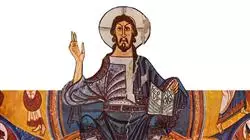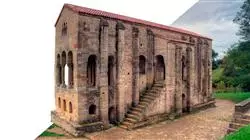University certificate
The world's largest faculty of humanities”
Introduction to the Program
The Christian faith has been the driving force behind the greatest body of works of art in the history of mankind”

Christian art can be found in different forms. There are paintings, architectures, sculptures, canvases, etc., all over the world that have served as the Church's letter of introduction. For a long time, it was believed that this form of expression derived from Paleochristianity, a degeneration of Roman art. But later it was shown that its beginnings were centered on the influence of classical realism, softened by Asian liveliness, producing works of clarity, beauty of form and sobriety of lines.
With these ideas, the first tempos were created, which were designed in the form of a Latin cross to represent the crucified Christ. Then, in the paintings, two modalities can be found, the first one is the mural, destined to the interior decoration of the tempos. And the second is the easel, in which images of the bible were depicted.
Thus, over the years, each expression has evolved and brought more people closer to the Church, either as faithful or as historians and artists seeking inspiration for their works. Therefore, studying this type of subject is essential for those professionals who wish to unravel the mysteries behind the art in every painting, brick and piece of glass.
For all this, this Postgraduate diploma will present a journey that begins with medieval art, through the Gothic art that dominated in France since the 12th century, culminating in the most representative expressions of the 20th century in Latin America. All this, contained in a program with a series of practical examples and an online modality, facilitating the learning of students from anywhere in the world.
Enroll now and you'll learn about the beauty behind Christian sculptures and their main representatives”
This Postgraduate diploma in Christian Art contains the most comprehensive and up-to-date academic program on the market. Its most notable features are:
- Practical cases presented by experts in Art History
- The graphic, schematic, and eminently practical contents with which they are created, provide scientific and practical information on the disciplines that are essential for professional practice
- Practical exercises where self-assessment can be used to improve learning
- Its special emphasis on innovative methodologies
- Theoretical lessons, questions to the expert, debate forums on controversial topics, and individual reflection assignments
- Content that is accessible from any fixed or portable device with an Internet connection
There is no better time than now to start working on a new approach to your career as an art expert”
The program’s teaching staff includes professionals from sector who contribute their work experience to this training program, as well as renowned specialists from leading societies and prestigious universities.
The multimedia content, developed with the latest educational technology, will provide the professional with situated and contextual learning, i.e., a simulated environment that will provide immersive training programmed to train in real situations.
This program is designed around Problem-Based Learning, whereby the professional must try to solve the different professional practice situations that arise during the academic year. For this purpose, the student will be assisted by an innovative interactive video system created by renowned and experienced experts.
You will enjoy a completely online program, allowing you to connect from anywhere in the world"

Learn how Christian iconography became so important after the conquest period"
Why study at TECH?
TECH is the world’s largest online university. With an impressive catalog of more than 14,000 university programs available in 11 languages, it is positioned as a leader in employability, with a 99% job placement rate. In addition, it relies on an enormous faculty of more than 6,000 professors of the highest international renown.

Study at the world's largest online university and guarantee your professional success. The future starts at TECH”
The world’s best online university according to FORBES
The prestigious Forbes magazine, specialized in business and finance, has highlighted TECH as “the world's best online university” This is what they have recently stated in an article in their digital edition in which they echo the success story of this institution, “thanks to the academic offer it provides, the selection of its teaching staff, and an innovative learning method aimed at educating the professionals of the future”
A revolutionary study method, a cutting-edge faculty and a practical focus: the key to TECH's success.
The most complete study plans on the university scene
TECH offers the most complete study plans on the university scene, with syllabuses that cover fundamental concepts and, at the same time, the main scientific advances in their specific scientific areas. In addition, these programs are continuously being updated to guarantee students the academic vanguard and the most in-demand professional skills. In this way, the university's qualifications provide its graduates with a significant advantage to propel their careers to success.
TECH offers the most comprehensive and intensive study plans on the current university scene.
A world-class teaching staff
TECH's teaching staff is made up of more than 6,000 professors with the highest international recognition. Professors, researchers and top executives of multinational companies, including Isaiah Covington, performance coach of the Boston Celtics; Magda Romanska, principal investigator at Harvard MetaLAB; Ignacio Wistumba, chairman of the department of translational molecular pathology at MD Anderson Cancer Center; and D.W. Pine, creative director of TIME magazine, among others.
Internationally renowned experts, specialized in different branches of Health, Technology, Communication and Business, form part of the TECH faculty.
A unique learning method
TECH is the first university to use Relearning in all its programs. It is the best online learning methodology, accredited with international teaching quality certifications, provided by prestigious educational agencies. In addition, this disruptive educational model is complemented with the “Case Method”, thereby setting up a unique online teaching strategy. Innovative teaching resources are also implemented, including detailed videos, infographics and interactive summaries.
TECH combines Relearning and the Case Method in all its university programs to guarantee excellent theoretical and practical learning, studying whenever and wherever you want.
The world's largest online university
TECH is the world’s largest online university. We are the largest educational institution, with the best and widest online educational catalog, one hundred percent online and covering the vast majority of areas of knowledge. We offer a large selection of our own degrees and accredited online undergraduate and postgraduate degrees. In total, more than 14,000 university degrees, in eleven different languages, make us the largest educational largest in the world.
TECH has the world's most extensive catalog of academic and official programs, available in more than 11 languages.
Google Premier Partner
The American technology giant has awarded TECH the Google Google Premier Partner badge. This award, which is only available to 3% of the world's companies, highlights the efficient, flexible and tailored experience that this university provides to students. The recognition as a Google Premier Partner not only accredits the maximum rigor, performance and investment in TECH's digital infrastructures, but also places this university as one of the world's leading technology companies.
Google has positioned TECH in the top 3% of the world's most important technology companies by awarding it its Google Premier Partner badge.
The official online university of the NBA
TECH is the official online university of the NBA. Thanks to our agreement with the biggest league in basketball, we offer our students exclusive university programs, as well as a wide variety of educational resources focused on the business of the league and other areas of the sports industry. Each program is made up of a uniquely designed syllabus and features exceptional guest hosts: professionals with a distinguished sports background who will offer their expertise on the most relevant topics.
TECH has been selected by the NBA, the world's top basketball league, as its official online university.
The top-rated university by its students
Students have positioned TECH as the world's top-rated university on the main review websites, with a highest rating of 4.9 out of 5, obtained from more than 1,000 reviews. These results consolidate TECH as the benchmark university institution at an international level, reflecting the excellence and positive impact of its educational model.” reflecting the excellence and positive impact of its educational model.”
TECH is the world’s top-rated university by its students.
Leaders in employability
TECH has managed to become the leading university in employability. 99% of its students obtain jobs in the academic field they have studied, within one year of completing any of the university's programs. A similar number achieve immediate career enhancement. All this thanks to a study methodology that bases its effectiveness on the acquisition of practical skills, which are absolutely necessary for professional development.
99% of TECH graduates find a job within a year of completing their studies.
Postgraduate Diploma in Christian Art
Christian art is an artistic style that has evolved over the centuries in Christian culture, and has been used to express the faith, devotion and history of the Christian religion. Its deepest roots in Antiquity are from the Roman Empire, in which the Christian religion was popularized. This era is characterized by the creation of Christian churches and basilicas, and the use of mosaics, frescoes and sculptures to adorn these religious buildings.
Christian art has also evolved over the centuries in different regions of the world. For example, during the Middle Ages in Europe, Christian art was noted for the creation of paintings and sculptures depicting biblical stories, as well as the construction of impressive Gothic cathedrals. In the modern era, Christian art has experienced a variety of styles, from traditional sacred art and oil painting to much more contemporary forms, such as pop art and installation.
Ultimately, Christian art is a form of artistic expression that has developed over many centuries and cultural regions. It aims to depict biblical stories, the life of Christ and religious devotion, and can take a variety of forms, from sculptures and paintings to architecture and modern art.
This academic program on Christian art focuses on the iconography, symbolism, and spiritual significance of images and objects, both from ancient and later periods. The goal of the program is to provide students with an in-depth understanding of Christian art forms throughout history. Students will learn to identify and analyze the techniques and styles employed in Christian art, as well as interpret the meanings and intentions behind these works of art.







